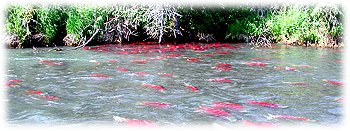

by Steve Duckett
| www.AlaskaFlyfishingOnline.com | ||
|
|

|

|
|
by Steve Duckett |
||
|
Helpful Area Fishing Maps Kenai Peninsula
|
Alaskan fish often hold on the bottom, and to get their attention your fly should be in their face, bouncing right along the bottom. Unfortunately, many of the standard fly patterns will hang up on the bottom, resulting in lost time, lost flies and lost opportunities. A new style of fly tying--developed especially for Alaskan waters--will result in more fish and fewer rocks.
This new style of fly gets down to the bottom, but seldom snags, due to its springy keel, which keeps the fly riding hook up and bounces the fly out of harm's way. In addition, the beads strung along the keel click together and against the bottom, sending out dinner signals to the fish. This bouncing, talking keel structure can be adapted to many fly patterns, including wooly buggers, flash flies, steelhead favorites, tube flies and even egg patterns. The springy keel is formed from a medium-stiff piece of mono with a number of beads strung along the mono. The beads can be heavy or light, small or large, brass, glass or plastic according to the requirements of the fly size and pattern. Very little weight is needed to keep the fly riding hook up, because the weighted keel is offset from the hook shank, providing much more leverage than conventional tying methods that have heavy eyes bound to the shank (where they are too near the axis of rotation). The tying steps are easy. In general, the mono is lashed to the shank first (with two inches of the free end extending to the rear), then the rest of the fly is built, and finally the mono is loaded with the beads and the end bent around to be tied in at the head of the fly. We are partial to Amnesia mono because of its color, but any mono will do. We use 25-lb on larger flies, and 15-lb on flies sized 6-10. The beads may be varied to adjust the weight distribution; for example, in the BuggerBouncer shown at the left side of the photo, we used a heavy brass bead under the head and lighter beads under the tail. This ability to tune the weighting can improve the action and reduce the chance that the fly will fall head down into a crack between two rocks, as sometimes happens with jig-style flies.
Editor's Note: Steve has been gracious enough to share a number of patterns he has tied using this innovative technique. We will be posting the recipes for these throughout the summer. In the meantime, we hope tiers will begin experimenting with modifying other successful patterns they use. You can visit Steve's website for further tying instructions by going to www.BouncerFlies.com
|